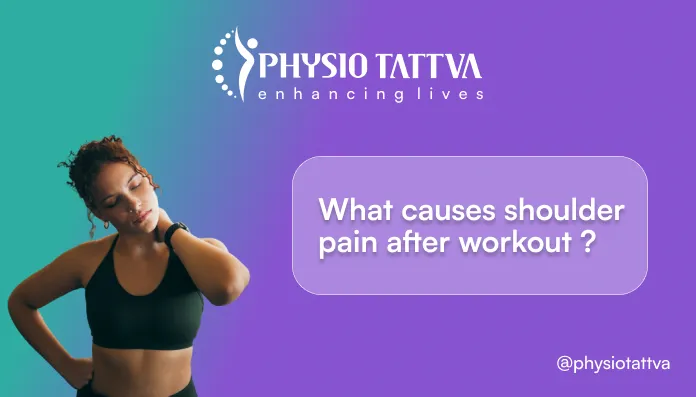Understanding the Grip of a Frozen Shoulder (Adhesive Capsulitis)
Before exploring the solution, it's crucial to understand the condition. A frozen shoulder occurs when the strong connective tissue surrounding your shoulder joint, known as the capsule, becomes thick, stiff, and inflamed. This process essentially causes the capsule to shrink and tighten around the joint, severely restricting its movement. The condition typically progresses through three distinct stages:
- The "Freezing" Stage: Gradual onset of pain. As the pain worsens, your shoulder loses range of motion.
- The "Frozen" Stage: Pain may begin to diminish, but stiffness becomes the primary symptom. The shoulder becomes increasingly difficult to move.
- The "Thawing" Stage: The range of motion slowly begins to improve.
Key symptoms you might recognise include a deep, aching pain in the shoulder, a significant loss of both active (what you can do) and passive (what a therapist can move for you) range of motion, and difficulty sleeping on the affected side.
What is Interferential Therapy (IFT)? A Deeper Look
Interferential Therapy, or IFT, may sound complex, but its principle is elegantly simple and highly effective. It is a specialised form of electrotherapy that uses two separate medium-frequency electrical currents. On their own, these currents have little effect. However, the magic happens where they are programmed to cross paths, or "interfere," deep within the affected tissue.
This interference effect produces a new, low-frequency therapeutic current right at the heart of the problem area. The key advantage of electrotherapy for shoulder stiffness like IFT is its ability to penetrate deeper than other electrical modalities, such as TENS (Transcutaneous Electrical Nerve Stimulation). While TENS is excellent for managing pain via superficial nerves, IFT can target the deep, inflamed shoulder joint capsule directly. Its primary goals are to provide powerful pain relief, reduce inflammation and swelling, and stimulate the body's natural healing processes.
How IFT Specifically Helps Relieve a Frozen Shoulder
This is where the science of IFT directly meets the challenge of adhesive capsulitis. Here’s how Interferential Therapy IFT for frozen shoulder provides targeted relief and accelerates your recovery:
- Pain Modulation (Pain Gate Theory): The therapeutic current generated by IFT stimulates the sensory nerves in the shoulder area. This stimulation effectively "closes the gate" on pain signals travelling to the brain. By flooding the nervous system with a comfortable tingling sensation, the brain perceives less pain from the shoulder joint. This provides immediate, drug-free pain relief, making daily life more manageable.
- Reduction of Inflammation and Swelling: IFT creates a physiological pumping effect in the deep tissues. This significantly enhances blood circulation and lymphatic drainage. Improved blood flow brings oxygen and nutrients to the area, while enhanced drainage helps to flush out inflammatory proteins and excess fluid that contribute to pain and stiffness within the tight joint capsule.
- Decreasing Muscle Spasm: The pain from a frozen shoulder often causes the surrounding muscles to go into a protective spasm. This guarding mechanism unfortunately, increases pain and further restricts movement, creating a vicious pain-spasm cycle. The gentle current from IFT helps these tense muscles to relax, breaking this cycle and providing an additional layer of relief.
- Facilitating Movement and Recovery: This is the most crucial benefit. IFT is not a passive cure; it is a powerful enabler. By dramatically reducing pain and relaxing muscle spasms, IFT for shoulder pain makes it possible for you and your physiotherapist to engage in the most critical parts of frozen shoulder treatment: manual therapy (joint mobilisation) and specific stretching exercises. This active recovery is essential for restoring your range of motion, and IFT makes it far more comfortable and effective.
The Physiotattva Experience: What to Expect During Your IFT Session
We understand that a new treatment can seem intimidating. At Physiotattva, we prioritise your comfort and confidence. Our patient-centric approach ensures you know exactly what to expect from your non-surgical shoulder pain relief journey.
- Step 1: Expert Assessment: Your journey begins with a comprehensive evaluation by one of our senior physiotherapists. We will assess your range of motion, pinpoint the source of your pain, and confirm the stage of your frozen shoulder to create a truly personalised treatment plan.
- Step 2: The Procedure: You will be made comfortable in a resting position. Our therapist will then place four small electrode pads on the skin around your shoulder joint. Once the machine is turned on, the intensity is slowly increased until you feel a gentle and comfortable tingling or buzzing sensation. It is not painful. A typical IFT session for a frozen shoulder lasts for about 15-20 minutes.
- Step 3: Post-Session Integration: Following the IFT session, your therapist will guide you through other aspects of your treatment plan, such as gentle stretches or manual therapy, capitalising on the pain relief the IFT has provided.
More Than a Modality: Our Integrated Approach to Frozen Shoulder Treatment
At Physiotattva, we believe in holistic, evidence-based care. While Interferential Therapy (IFT) is a powerful tool for frozen shoulder, the best and most lasting results come from an integrated adhesive capsulitis physiotherapy plan. We use IFT as part of a multi-faceted strategy that includes:
- Manual Therapy: Hands-on techniques where our therapists perform gentle joint mobilisations and stretches to the shoulder capsule to progressively restore movement.
- Targeted Exercise Prescription: A customised home exercise program with specific stretching and strengthening exercises designed to regain your range of motion, improve stability, and restore function.
- Patient Education: We empower you with a deep understanding of your condition, postures to avoid, and self-management strategies to prevent recurrence.
Effective Frozen Shoulder Recovery Starts with IFT and Expert Care at Physiotattva
A frozen shoulder can put your life on hold, but you don’t have to suffer through it. As a key component of a comprehensive physiotherapy plan, Interferential Therapy (IFT) for frozen shoulder is a proven, evidence-based treatment that offers significant pain relief, reduces inflammation, and accelerates your return to an active, pain-free life.
If pain and stiffness are holding you back, you don’t have to face it alone. Take the first step toward restoring comfort, movement, and confidence! Book your consultation with Physiotattva today.
At Physiotattva physiotherapy clinics in Bangalore and Hyderabad, you receive personalised care tailored to your specific needs, ensuring effective results and comfort throughout your journey to recovery.
Don’t wait to start your recovery! Get in touch with Physiotattva for more details! Contact us at +91 89510 47001.



-Physiotherapy.webp)
-for-Shoulder-Pain-Relief.webp)
-for-Knee-Pain-Relief.webp)


-for-Back-Pain-Relief%20(1).webp)





.webp)











.webp)


.webp)





.webp)
.webp)


.webp)
.webp)

.webp)

.webp)

.webp)
.webp)

.webp)
.webp)



.png)






%20(1)-p-3200.jpeg)


.jpg)
.webp)
.webp)
.webp)



